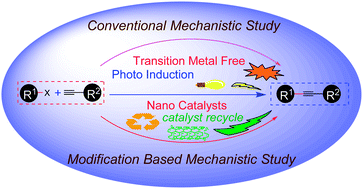Recent mechanistic developments and next generation catalysts for the Sonogashira coupling reaction
Abstract
The Pd-catalyzed Sonogashira reaction is a powerful method for the formation of Csp2–Csp bonds and has found application in a wide variety of areas including medicinal chemistry, agrochemistry, materials and electronics. Development of competent catalysts for the Sonogashira reaction is a particular scientific challenge since it is traditionally a di-metallic-mediated homogeneous catalytic process including some major drawbacks. This review provides a concise overview of the mechanistic aspects of the Cu co-catalyzed, Cu-free and Au-catalyzed Sonogashira coupling processes. More recent developments and next generation catalysts for the Sonogashira reaction are also presented. These include non transition-metal catalysts, metal free couplings and photo-induced protocols. Finally, the application of metal nanoparticles in Sonogashira reactions is presented. These include Pd nanoparticles, Pd bi- and tri-metallic nanoparticles, magnetically separable Pd/Fe3O4 nanoparticles, Ru nanoparticles and Au nanoparticles.


 Please wait while we load your content...
Please wait while we load your content...